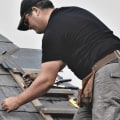Built-up roof systems (BUR) are one of the most popular and reliable roofing systems available for commercial buildings. They have a long history of providing durable and long-lasting protection from the elements, and they can be customized to suit any type of building. In this comprehensive overview, we'll discuss the different types of BURs, how they are built, their advantages and disadvantages, and more. BURs are made up of several layers of asphalt-saturated felt or fiberglass mats that are covered with a protective layer of gravel, tar, or modified bitumen. The mats are then overlaid with an asphalt-based protective coating to prevent water from penetrating the roof.
This system is highly resistant to wind, hail, and other environmental elements, making it an ideal choice for commercial buildings. When installing a BUR system, it is important to make sure that the seams are properly sealed to prevent water from entering the roof. Additionally, the BUR system should be inspected regularly to ensure that it is in good condition. By taking these steps, you can ensure that your commercial building is well protected from the elements.
Advantages of Built-up Roof Systems
Built-up roof systems, or BUR, offer a number of advantages compared to other commercial roofing options. One of the main benefits of using a built-up roof system is durability.BURs are designed to last up to 30 years when properly installed and maintained, making them a great long-term investment. Additionally, built-up roof systems are cost-effective, offering protection from the elements at a lower cost than other roofing options. In terms of energy efficiency, BURs are highly effective. Built-up roofs feature multiple layers of insulation, which can help reduce energy costs in both warm and cold climates.
Furthermore, these roofs require minimal maintenance, meaning less effort and money is needed to keep them in good condition.
Materials Used in Construction
Asphalt is the primary material used in a built-up roof system. It is made up of layers of asphalt-saturated felt or fiberglass mats that are then covered with a layer of hot asphalt and a top layer of gravel or mineral granules. The asphalt provides waterproofing, while the gravel offers additional protection from the elements.Felt
is the second layer in a built-up roof system.It is composed of organic or inorganic fibers that are saturated with asphalt and then compressed into a sheet. Felt is designed to protect the underlying materials from damage due to weathering and temperature changes.
Modified Bitumen
is a more modern material used in built-up roof systems. It consists of a plastic or rubber-based sheet that is laminated with asphalt and then reinforced with polyester fibers.Modified bitumen provides greater resistance to water and ultraviolet radiation, making it more durable than traditional felt.
Gravel
is the top layer in a built-up roof system. It is composed of small stones or rocks that are embedded in asphalt to protect the roof from extreme temperatures, ultraviolet rays, and other environmental factors. The gravel also provides an aesthetically pleasing finish to the roof.Installation Process
When installing a built-up roof system, it is important to use high-quality materials and follow all manufacturer's instructions.The roof should be inspected before installation to ensure that it is free from any defects or damage. This inspection should include an assessment of the structural integrity of the building, as well as an inspection for any signs of wear and tear or damage. Once the inspection has been completed, the installation process can begin. The first step in installing a built-up roof system is to prepare the surface. This involves applying a layer of asphalt or tar paper over the existing roof.
This layer helps to protect the underlying structure from moisture and other elements. Next, a layer of felt paper is applied on top of the asphalt or tar paper. Once the felt paper has been installed, the BUR membrane can be applied. This membrane is composed of several layers of asphalt and felt paper, which are then covered with an additional layer of felt paper for extra protection. The BUR membrane is then secured with fasteners such as nails or screws, which are driven into the roof decking. After the membrane has been installed, a layer of gravel is spread over the roof.
This gravel helps to protect the roof from UV rays and other elements, while also providing additional insulation against heat and cold. Finally, flashing materials are used to seal off any seams or joints in the roof. Installing a built-up roof system requires experience and precision to ensure that it is properly installed. It is important to consult with a professional roofer if you are unsure about the installation process or have any questions. With proper care and maintenance, a built-up roof system can last for decades.










